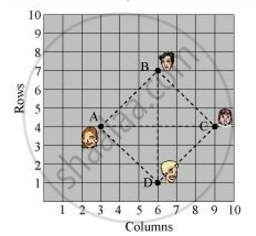Advertisements
Advertisements
प्रश्न
In a classroom, 4 friends are seated at the points A, B, C and D as shown in the following figure. Champa and Chameli walk into the class and after observing for a few minutes, Champa asks Chameli, “Don’t you think ABCD is a square?” Chameli disagrees.
Using distance formula, find which of them is correct.

उत्तर
It can be observed that A (3, 4), B (6, 7), C (9, 4), and D (6, 1) are the positions of these 4 friends.
AB = `sqrt((3-6)^2+(4-7)^2)`
= `sqrt((-3)^2+(-3)^2)`
= `sqrt(9+9)`
= `sqrt18`
= `3sqrt2`
BC = `sqrt((6-9)^2+(7-4)^2) `
= `sqrt((-3)^2+(3)^2)`
= `sqrt(9+9)`
= `sqrt18`
= `3sqrt2`
CD = `sqrt((9-6)^2+(4-1)^2)`
= `sqrt((3)^2+(3)^2)`
= `sqrt(9+9)`
= `sqrt18`
= `3sqrt2`
AD = `sqrt((3-6)^2+(4-1)^2)`
= `sqrt((-3)^2 + (3)^2)`
= `sqrt(9+9)`
= `sqrt18`
= `3sqrt2`
Diagonal AC = `sqrt((3-9)^2+(4-4)^2)`
= `sqrt((-6)^2)`
= 6
Diagonal BD = `sqrt((6-6)^2+(7-1)^2)`
= `sqrt((6)^2)`
= 6

It can be observed that all sides of this quadrilateral ABCD are of the same length and also the diagonals are of the same length.
Therefore, ABCD is a square and hence, Champa was correct.
APPEARS IN
संबंधित प्रश्न
If two vertices of an equilateral triangle be (0, 0), (3, √3 ), find the third vertex
Find the distance between the points (0, 0) and (36, 15). Can you now find the distance between the two towns A and B discussed in Section 7.2.
Determine if the points (1, 5), (2, 3) and (−2, −11) are collinear.
Given a line segment AB joining the points A(–4, 6) and B(8, –3). Find
1) The ratio in which AB is divided by y-axis.
2) Find the coordinates of the point of intersection.
3) The length of AB.
Given a triangle ABC in which A = (4, −4), B = (0, 5) and C = (5, 10). A point P lies on BC such that BP : PC = 3 : 2. Find the length of line segment AP.
`" Find the distance between the points" A ((-8)/5,2) and B (2/5,2)`
Find the coordinate of O , the centre of a circle passing through P (3 , 0), Q (2 , `sqrt 5`) and R (`-2 sqrt 2` , -1). Also find its radius.
Prove that the points (7 , 10) , (-2 , 5) and (3 , -4) are vertices of an isosceles right angled triangle.
Prove that the points (a, b), (a + 3, b + 4), (a − 1, b + 7) and (a − 4, b + 3) are the vertices of a parallelogram.
PQR is an isosceles triangle . If two of its vertices are P (2 , 0) and Q (2 , 5) , find the coordinates of R if the length of each of the two equal sides is 3.
Find the distance between the origin and the point:
(-5, -12)
The distance between the points (3, 1) and (0, x) is 5. Find x.
What point on the x-axis is equidistant from the points (7, 6) and (-3, 4)?
Given A = (3, 1) and B = (0, y - 1). Find y if AB = 5.
Show that P(– 2, 2), Q(2, 2) and R(2, 7) are vertices of a right angled triangle
The point which lies on the perpendicular bisector of the line segment joining the points A(–2, –5) and B(2, 5) is ______.
The distance of the point P(–6, 8) from the origin is ______.
Find the value of a, if the distance between the points A(–3, –14) and B(a, –5) is 9 units.
The centre of a circle is (2a, a – 7). Find the values of a if the circle passes through the point (11, – 9) and has diameter `10sqrt(2)` units.
|
Tharunya was thrilled to know that the football tournament is fixed with a monthly timeframe from 20th July to 20th August 2023 and for the first time in the FIFA Women’s World Cup’s history, two nations host in 10 venues. Her father felt that the game can be better understood if the position of players is represented as points on a coordinate plane. |
- At an instance, the midfielders and forward formed a parallelogram. Find the position of the central midfielder (D) if the position of other players who formed the parallelogram are :- A(1, 2), B(4, 3) and C(6, 6)
- Check if the Goal keeper G(–3, 5), Sweeper H(3, 1) and Wing-back K(0, 3) fall on a same straight line.
[or]
Check if the Full-back J(5, –3) and centre-back I(–4, 6) are equidistant from forward C(0, 1) and if C is the mid-point of IJ. - If Defensive midfielder A(1, 4), Attacking midfielder B(2, –3) and Striker E(a, b) lie on the same straight line and B is equidistant from A and E, find the position of E.

